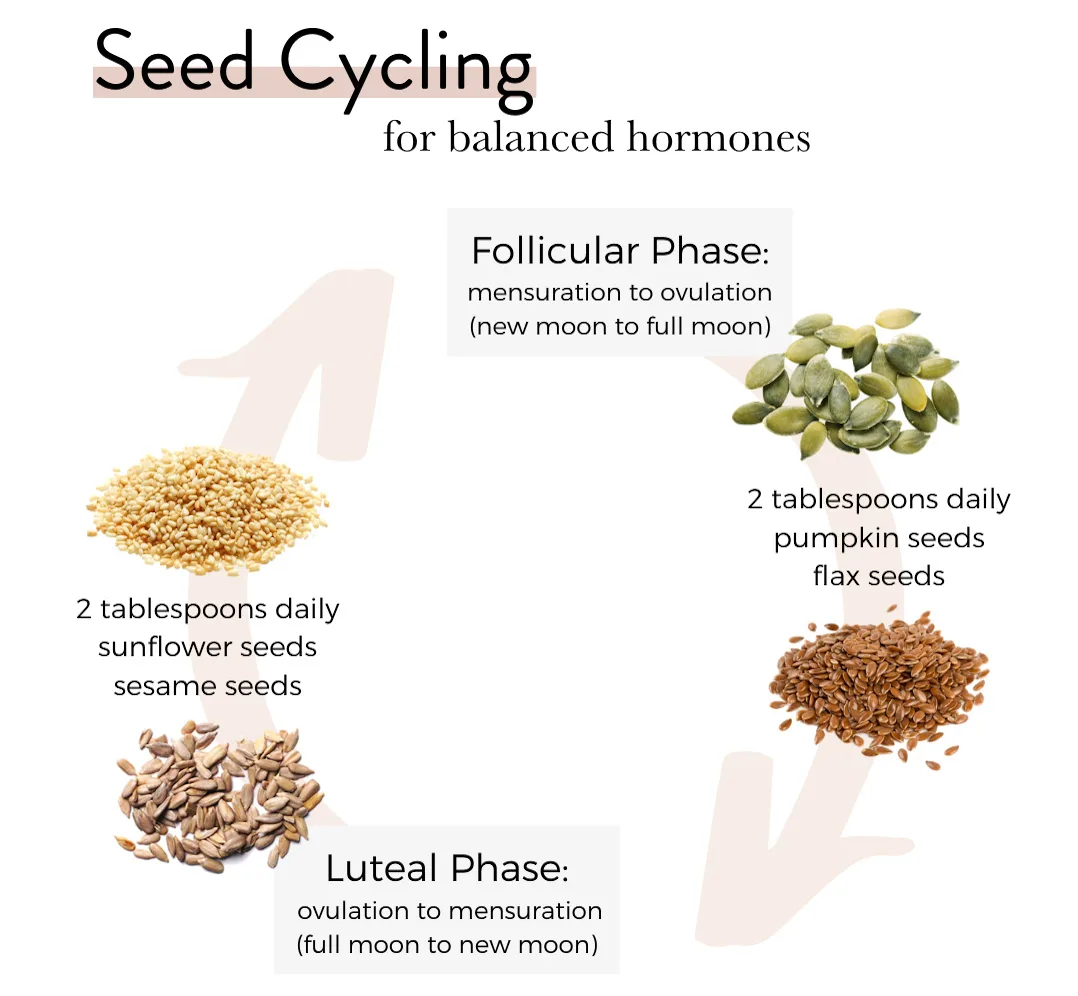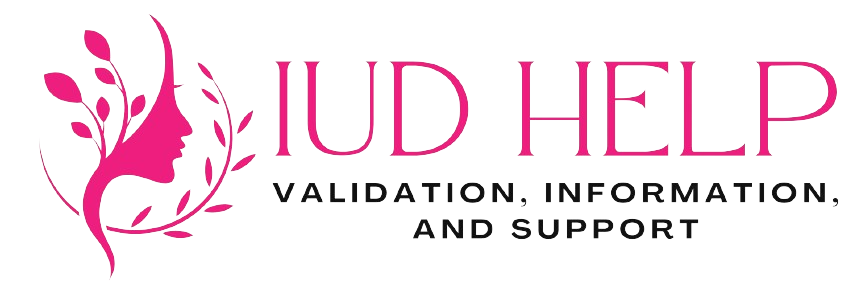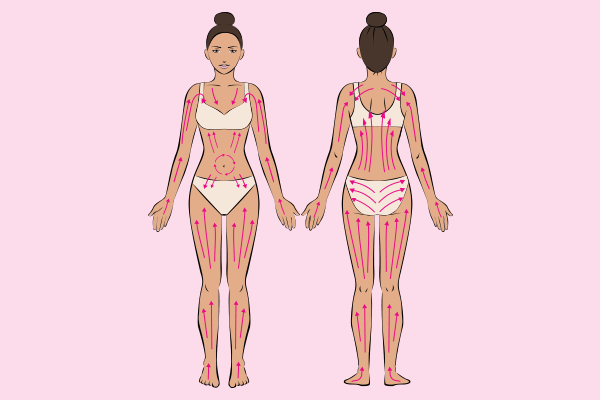Seed Cycling for Balanced Hormones
Seed cycling with the moon is a holistic practice that has been embraced for centuries. Recently, it has gained increased popularity, especially as more women face hormonal imbalances. This method involves consuming different seeds in sync with the phases of the menstrual cycle, which correspond with the phases of the moon.
What is Seed Cycling with the Moon?
Seed cycling with the moon involves rotating the consumption of various seeds (pumpkin, flax, sunflower, and sesame) in tandem with the moon’s phases. This practice aims to balance hormone production, benefiting menstrual health and fertility. Hormonal imbalances, particularly in estrogen and progesterone, can lead to symptoms such as cramping, acne, anovulation, and short luteal phases. Seed cycling with the moon can help regulate menstrual cycles, balance hormonal health, and enhance fertility.
Understanding the Menstrual Cycle
The menstrual cycle has four phases:
- Menstrual Phase: This phase starts when menstruation begins, typically lasting 3-7 days. Estrogen and progesterone levels are at their lowest.
- Follicular Phase: During this phase, follicle-stimulating hormone stimulates the ovaries to produce follicles, and estrogen rises. This phase lasts from day 1 to 14, overlapping with menstruation.
- Ovulation: Around day 14, luteinizing hormone triggers the release of a mature egg, marking the most fertile period.
- Luteal Phase: This phase follows ovulation, from days 15 to 28. Progesterone rises, and estrogen decreases as the body prepares for a potential pregnancy.
Phases of the Moon
The moon also cycles through phases approximately every 28 days:
- New Moon: The moon is not visible.
- Waxing Moon: Includes waxing crescent, first quarter, and waxing gibbous phases, where the moon gradually becomes more visible.
- Full Moon: The moon is fully illuminated and visible.
- Waning Moon: Includes waning gibbous, last quarter, and waning crescent phases, where the moon gradually becomes less visible until it cycles back to a new moon.
The Moon and the Menstrual Cycle: How They Coincide
The phases of the moon align with the menstrual cycle: the follicular phase aligns with the new moon, and the luteal phase aligns with the full moon. Ovulation, occurring around the full moon, matches the mid-cycle peak. Now, if your cycle doesn’t match up with the moon’s cycle, that’s okay. Each woman’s cycle is unique, and seed cycling can still be beneficial regardless of this alignment.
How Seed Cycling with the Moon Can Optimize Your Hormonal Health
Though the so-called “normal” menstrual cycle occurs within a 28-day period, most women tend to experience a cycle anywhere from every 21 to 35 days. This is normal!
However, when progesterone or estrogen levels are imbalanced, you may experience symptoms such as:
- Menstrual cramps
- Heavy periods
- Acne
- Mood changes
- Irregular cycles
- Shorter luteal phases
- Anovulation (lack of ovulation)
- Amenorrhea (lack of menstruation)
Seed cycling helps restore balance through the nutritional components of seeds, such as phytoestrogens and lignans.

The Science Behind Seed Cycling with the Moon
- Pumpkin and Flax Seeds: These seeds are rich in omega-3 fatty acids, promoting fertility and reducing ovulatory dysfunction. They help regulate estrogen levels during the follicular phase.
- Sesame and Sunflower Seeds: These seeds enhance progesterone levels and help detoxify excess estrogen during the luteal phase.
To fully unlock the benefits of the seeds, it’s essential to grind them before consumption. This enhances their digestibility and allows for better absorption of nutrients.
Nutritional Benefits of Seeds
- Pumpkin Seeds: Rich in magnesium, zinc, omega-3 fatty acids, and antioxidants, pumpkin seeds support hormonal balance and immune function.
- Flax Seeds: High in omega-3 fatty acids, lignans, and fiber, flax seeds help regulate estrogen levels and improve digestion.
- Sunflower Seeds: Loaded with vitamin E, selenium, and healthy fats, sunflower seeds aid in progesterone production and reduce inflammation.
- Sesame Seeds: Packed with lignans, calcium, magnesium, and zinc, sesame seeds support bone health, hormonal balance, and detoxification.
Key Nutrients in Seed Cycling
- Phytoestrogens: Found in pumpkin, flax, sesame, and sunflower seeds, these compounds help balance estrogen levels.
- Lignans: Particularly abundant in flaxseeds, lignans support hormone balance by regulating estrogen levels.
- Omega-3 Fatty Acids: Essential for healthy cell membranes and increased progesterone levels, found in flax and pumpkin seeds.
- Zinc: Present in pumpkin and sesame seeds, zinc aids in ovulation and progesterone production.
- Selenium: Abundant in sunflower seeds, selenium supports estrogen detoxification.
How to Implement Seed Cycling with the Moon
- Follicular Phase (New Moon to Full Moon): Consume 1-2 tablespoons of pumpkin and flax seeds daily for the first 14 days.
- Luteal Phase (Full Moon to New Moon): Switch to 1-2 tablespoons of sunflower and sesame seeds daily for the next 14 days.
Tips and Tricks for Seed Cycling with the Moon
- Top Quality Selection: Ensure your seeds are organic, non-GMO, and whole for the best results.
- Simple Dosage: Consume 1 to 2 ground tablespoons of each seed daily as part of your seed cycling routine.
- Maximize Benefits: Grind your seeds using a coffee grinder or blender to enhance digestibility and nutrient absorption, ensuring you reap the full advantages of seed consumption.
- Proper Storage: Store seeds in the refrigerator or freezer to maintain freshness.
- Keep Track: Use a journal or digital app to monitor your cycle, symptoms, and seed intake.
How Long Does It Take to Notice Results?
Seed cycling with the moon takes time to balance your hormones. You may start noticing benefits within 90 days (about 3 months). It’s important to note that changes made in cycle 1 won’t be noticeable until cycle 3, so patience and consistency are key.
Incorporating Seeds into Your Daily Routine
Breakfast Ideas:
- Add ground seeds to smoothies, yogurt, oatmeal, chia pudding, or avocado toast.
- Make ground seed butter for oatmeal, smoothies, or spreading on toast.
- Include ground seeds in granola, cereal, muffins, energy balls, or breakfast cookies.
Lunch and Dinner Ideas:
- Add ground seeds to salads, soups, or buddha bowls.
- Mix ground seeds into pesto, sauces, or dressings.
- Use ground seed butter for sandwiches.
Dessert Ideas:
- Sprinkle ground seeds on fruit salads, ice cream, or baked goods.
- Make seed-friendly chocolate bark.
Seed cycling with the moon is a natural approach to balancing hormones, reducing PMS symptoms, and enhancing fertility. It involves understanding your menstrual cycle, aligning it with the moon phases, and incorporating the nutritional benefits of seeds into your diet. While it may take a few months to notice significant changes, the potential benefits for hormonal health and overall well-being make it a worthwhile practice.
Guides, Fact Sheets, and Handouts
Seed cycling is a natural approach to hormone balance that involves eating specific seeds at different phases of your menstrual cycle. This fact sheet provides insights into the benefits and practical steps of seed cycling, facilitating its integration into your daily routine. To learn more about seed cycling, visit our Seed Cycling Web Page. or download our Seed Cycling Fact Sheet for additional tips and information.
Removing an intrauterine device (IUD) at home is not recommended for everyone, but for those who choose this path, it’s important to understand the process and potential risks. This guide is designed to provide you with the necessary information to safely remove your IUD on your own, especially if you don’t have access to a healthcare provider who is willing to do it for you.
Dry Brushing for Detoxification Handout
Dry brushing is a simple, ancient practice that involves brushing your skin with a dry, stiff-bristled brush to promote detoxification and overall well-being. This handout provides you with the benefits, steps, and tips to incorporate dry brushing into your daily routine.
We improve our products and advertising by using Microsoft Clarity to see how you use our website. By using our site, you agree that we and Microsoft can collect and use this data. For further details, please refer to our comprehensive Privacy Policy.



